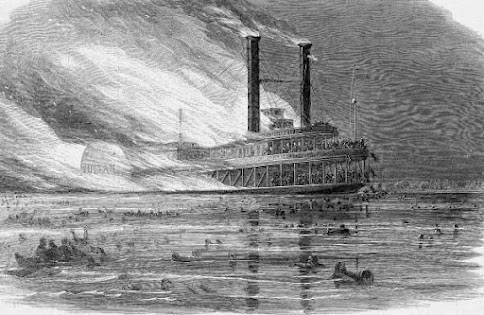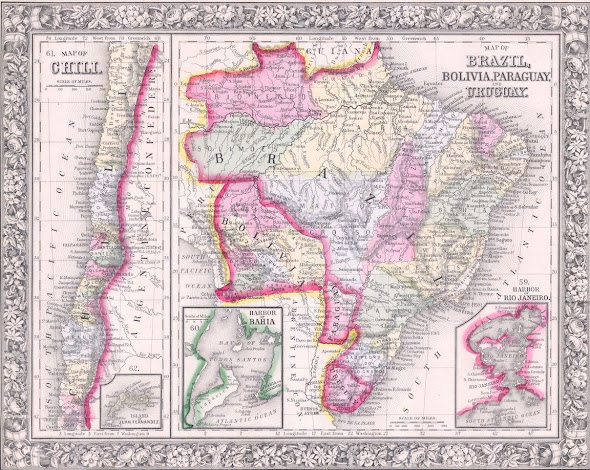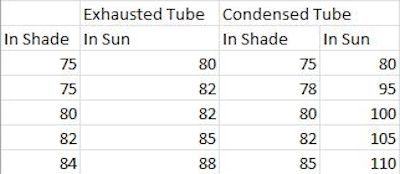River Boats and the Boeing 737
The Sultana explodes on the Mississippi north of Memphis April 27, 1865. Over 1,500 people of the 2,000 aboard died.
River Boats--And you think the Boeing 737 is unsafe??!! Most of us have a vision of steamboats formed by movies and TV. There is the classic musical Showboat. And I remember James Garner in the old TV series Maverick about a riverboat gambler. The show's theme music ended with the lyrics "Luck is the lady he loves best."
You bet! (pardon the pun.) Safety standards were non existent. Riverboat journeys themselves were a gamble. With little to no regulation and no safety features, riverboats were floating death traps. A July 1860 St. Louis newspaper reported matter-of-factly that 267 riverboats had exploded, burned, sunk, collided, or run aground between St Louis and New Orleans in the previous six months!
The deadliest river boat loss occurred when the Sultanah exploded in April 27,1865. Over 1,500 of the 2,400 people aboard died, many of them former Union POWs on their way home. An inquest found the boat had a capacity of no more than 350 including a crew of 85!
Exploding steam boilers were the modern equivalent of a jet airliner exploding in midair. The loss of life was always great from burns, concussion, and the simple fact most people could not swim and were weighed down in heavy clothes.
Cargo (often, cotton bales) caught fire from sparks from passing steamboats’ smokestacks or a carelessly tossed lit cigar (cigarettes had not yet been invented); collisions; hitting submerged rocks, tree trunks, and old riverboat wrecks claimed others. Even running aground on a new and uncharted sandbar could crack or break the hull or, at least, delay the boat’s schedule. Storms were a great a threat to riverboats with shallow draft and little keel.
Riverboats were not entirely safe even when tied up at a wharf. In 1843, a riverboat docked at St. Louis caught fire. The fire spread to 23 other boats as well as burning down half of the town.
So, why ride a riverboat? Previously, barges used oars or simply drifted downstream. Before steam boats, a trip up the Mississippi to the village called St. Louis from New Orleans might take more than a month. Steam power allowed freedom of movement and speed. A river boat rarely topped 15 mph, but that was lightening compared to using sails or being pulled upstream by mules.
The impact was quick. In 1821 there were 21 landings by primitive riverboats in New Orleans; in 1833, over 2,000.
The losses on the Mississippi spurred one of the early Federal regulations, the 1836 River Navigation Act which set up a primitive system of inspections. This regulation was followed by stricter River Navigation Rules, including, requiring riverboat pilots to pass a rugged apprenticeship and test before being allowed to be hired as a riverboat pilot. Riverboat pilots earned high salaries after an apprenticeship lasting several years, to become a master pilot on a particular river or a stretch of the river. Being certified on the Lower Mississippi for example, did not qualify a pilot to work on, say, the Tennessee River.
Samuel Clemmons--Mark Twain—was about to become a master river pilot on the Mississippi when the Civil War broke out. It was also about that time that Clemmons’ younger brother was hideously burned in a boiler explosion and died in Clemmons’ arms several days later. Clemmons never forgave himself for having encouraged his younger brother to follow him into the river pilot profession.
On the Tennessee River
Today, we think of
steamboats plying only the Ohio and Mississippi but in an era of few roads and
nascent railroads, dozens of rivers had steamboat services.
Wilmington & Fayetteville
Passenger Line
The new steamer MAGNOLIA will leave Fayetteville (NC)Tuesdays and Fridays at 15 minutes after sunrise, and Wilmington Wednesdays and Saturdays at __o'clock.
Passage $4 T.S.LUTTERLOH
June 14 (1853?)
Like modern airports,
river wharves, and harbors along the shores charged a fee depending on what was
being loaded or unloaded and how long it took. Since rivers rise and fall, most river ports had wharf boats, primarily floating rafts which rose and fell with the river level, making it much easier to load and unload a boat.
Riverboats carried immense amounts of cargo, particularly after the Civil War.
River landings were
shallow, so river boats did not have deep cargo holds. Room had to be allowed for the steam boiler,
smokestack, wood or coal for the steam boiler, and the drive shafts connecting
the gears to the side paddles or rear paddles. Passengers and cargo were
stacked together on the main deck.
Building
a housing around the engine and gears on a riverboat allowed a pilot house to be built on
top. Rooms for wealthier passengers were soon added.
Rivers constantly
change; depth varies with floods or drought; a sandbar builds up one week and
disappears the next; rocks and large fallen trees submerged beneath the surface
might break the vanes on a boat’s paddles even if they didn’t tear a hole in
boat itself.
Memphis Feb. 6, 1861
WRECKED--When The Dicky came down from St Louis she passed the H.D.Bacon up from New Orleans, lying a wreck twenty-five miles above Cairo. When going with a full head of steam, she had struck a hard and rocky reef with such violence it shivered a great number of her timbers. She contrived to run in shore and land most of her cargo.
Riverboats seldom lasted
longer than five years or so. If an accident didn’t sink them, poor maintenance
left the wood hulls quickly rotting to pieces. Building a new boat in Pittsburgh was worth it if for no other reason than the
technology and designs progressed rapidly. There was no point to repairing or
maintaining a boat that would be obsolete in five years.
Rotting away
Newspapers published "River News" regularly--who was arriving and who was leaving as well as water levels of the rivers at various locations.
River News Memphis, TN Nov. 16, 1860









I learned a new word: "lade". Most interesting post.
ReplyDelete